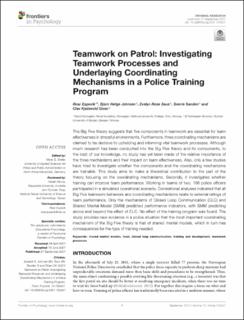| dc.contributor.author | Espevik, Roar | |
| dc.contributor.author | Johnsen, Bjørn Helge | |
| dc.contributor.author | Saus-Rose, Evelyn | |
| dc.contributor.author | Sanden, Sverre | |
| dc.contributor.author | Olsen, Olav Kjellevold | |
| dc.date.accessioned | 2021-09-09T06:26:26Z | |
| dc.date.available | 2021-09-09T06:26:26Z | |
| dc.date.created | 2021-09-07T14:59:28Z | |
| dc.date.issued | 2021 | |
| dc.identifier.issn | 1664-1078 | |
| dc.identifier.uri | https://hdl.handle.net/11250/2774785 | |
| dc.description.abstract | The Big Five theory suggests that five components in teamwork are essential for team effectiveness in stressful environments. Furthermore, three coordinating mechanisms are claimed to be decisive to upholding and informing vital teamwork processes. Although much research has been conducted into the Big Five theory and its components, to the best of our knowledge, no study has yet been made of the relative importance of the three mechanisms and their impact on team effectiveness. Also, only a few studies have tried to investigate whether the components and the coordinating mechanisms are trainable. This study aims to make a theoretical contribution to the part of the theory focusing on the coordinating mechanisms. Secondly, it investigates whether training can improve team performance. Working in teams of two, 166 police officers participated in a simulated operational scenario. Correlational analyses indicated that all Big Five teamwork behaviors and coordinating mechanisms relate to external ratings of team performance. Only the mechanisms of Closed Loop Communication (CLC) and Shared Mental Model (SMM) predicted performance indicators, with SMM predicting above and beyond the effect of CLC. No effect of the training program was found. The study provides new evidence in a police situation that the most important coordinating mechanism of the Big Five theory is that of shared mental models, which in turn has consequences for the type of training needed. | en_US |
| dc.language.iso | eng | en_US |
| dc.publisher | Frontiers Media | en_US |
| dc.rights | Navngivelse 4.0 Internasjonal | * |
| dc.rights.uri | http://creativecommons.org/licenses/by/4.0/deed.no | * |
| dc.title | Teamwork on Patrol: Investigating Teamwork Processes and Underlaying Coordinating Mechanisms in a Police Training Program | en_US |
| dc.type | Journal article | en_US |
| dc.type | Peer reviewed | en_US |
| dc.description.version | publishedVersion | en_US |
| dc.rights.holder | Copyright 2021 Espevik, Johnsen, Saus, Sanden and Olsen | en_US |
| dc.source.articlenumber | 702347 | en_US |
| cristin.ispublished | true | |
| cristin.fulltext | original | |
| cristin.qualitycode | 1 | |
| dc.identifier.doi | 10.3389/fpsyg.2021.702347 | |
| dc.identifier.cristin | 1932121 | |
| dc.source.journal | Frontiers in Psychology | en_US |
| dc.identifier.citation | Frontiers in Psychology. 2021, 12, 702347. | en_US |
| dc.source.volume | 12 | en_US |

